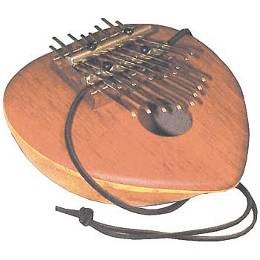Resource 5: Traditional musical instruments
![]() Background information / subject knowledge for teacher
Background information / subject knowledge for teacher
Traditional Zambian instruments include a variety of membranophones [Tip: hold Ctrl and click a link to open it in a new tab. (Hide tip)] , both stick-struck and hand-struck. Drums are essential for most traditional dances. Ngoma is the generic central African term for drum but Zambian drums come in a variety of sizes, shapes and purposes and have specific names depending on their tribal origins and functional roles. The budima drums of the Valley Tonga, for example, are used specifically for funeral ceremonies. Budima drums have a goblet shape and come in sizes ranging from large to small.

Budima drums
Adapted from: Open Entry International
One of the most interesting drums is the so-called ‘lion drum’ (Namalwa in Tonga) used at traditional funerals. This is a friction drum which is not struck at all but which has a stick inserted through the drum head that is rubbed.
The silimba, a xylophone-like instrument, is another Zambian musical instrument.
Chordophones and aerophones are less common in traditional Zambian music but exist nonetheless. The Valley Tonga play instruments made from animal horns called nyele. Nyele are played using an interlocking technique with individual musicians each playing a single horn and interlocking with other musicians who have nyele of different pitches. A chordophone called a kalumbu was traditionally played by young men to signal their desire to marry. Called a 'musical bow' by ethnomusicologisits because of its bow shape, the kalumbu is struck by a stick. Like many other central African countries, Zambia once had a vibrant tradition of so-called ‘thumb pianos’, each with a different name depending on tribal origins, size and number of tines. Similar to the Zimbabwean mbira, the Tonga kankobela is one such thumb piano. Although the use of traditional instruments has declined in recent years, they can still be heard in rural areas of Zambia.

Mbira
Adapted from: Music Viriginia Tech, Website
Recordings of traditional Zambian music were made in the mid-20th century by Hugh Tracey and Arthur Morris Jones, both well-known ethnomusicologists of African music. Tracey did his work in the Zambezi Valley before the creation of the Kariba Dam and Jones did his at Mapanza in Zambia's Southern Province. Catholic missionaries, J J Corbeil and Frank Wafer have also contributed to our knowledge of traditional Zambian music. Father Corbeil collected and documented the instrumental tradition of the Bemba in Northeastern Zambia. Frank Wafer, a Jesuit priest located at Chikuni, has collected and preserved Batonga music. A community radio station dedicated to promoting Batonga music and culture is also part of the Chikuni Mission Station. They organise an annual festival of Batonga music, which attracts as many as 10,000 visitors according to the organisers. Recent ethnomusicological work has been done by native Zambians such as Mwesa Isaiah Mapoma, Joseph Ng'andu and others.
Adapted from: Wikipedia, WebsiteResource 4: Ideas for judging each instrument



